By Leo Byrne, Contributing Reporter

RIO DE JANEIRO, BRAZIL – Residents around the Lagoa Rodrigo de Freitas in Rio have had their usually picturesque surroundings spoiled this week as low oxygen levels in the water, caused thousands of fish to suffocate and float to the surface.
The usually scenic surroundings at Lagoa were ruined this week by thousands of dead fish, image recreation.
In response, Rio’s waste disposal company Comlurb employed 180 employees working alongside four boats in order to clear up the dead fish that started appearing on Tuesday morning. Since then they have collected more than 65 tones of fish, crabs and shrimp.
While concerns arose that Lagoa’s occasionallypolluted water was the source of the problem, the secretariat of the environment was quick to point to less sinister reasons, attributing the strange scene to recent storms and heavy rainfall.
“We did not detect the inflow of any exceptional levels of sewage. We recently had two heavy rain storms that brought organic material into the Lagoon,” the municipal secretary of the environment Carlos Alberto Muniz told O Globo.
Even though the lagoon is open to the ocean via a canal along the Jardim de Alá, the water does not circulate quickly, meaning that the organic matter could be problematic for oxygen levels within the lake.
“Such organic matter causes the proliferation of microbes that consume oxygen in the water. While it’s possible that the matter originates from sewage, the low concentration of oxygen could be also due to [other factors] like high temperatures or rain increasing the existence of organic matter in the water,” Tiago Fernandes, sanitation and water safety expert at UFRJ told The Rio Times.
The fatally low levels of oxygen in the water meant that the fish and sea life in the lagoon have been perishing in droves, while also rendering seventy percent of the lagoon unusable for recreational activity. The timing of the storms was particularly poor as it flushed the organic material into the water shortly after the fish’ breeding season, meaning that their populations were unusually high.
The macabre image of thousands of dead fish is a potential headache for the state of Rio de Janeiro given that the lagoon will host the rowing events in the 2016 Olympics. The secretariat of the environment pointed out that a buoy in the center of the lagoon monitors pollution levels in real time.
A project is also planned to increase the lagoon’s water circulation by extending its connection to the ocean.
Read more (in Portuguese)
Source: The Rio Times Daily